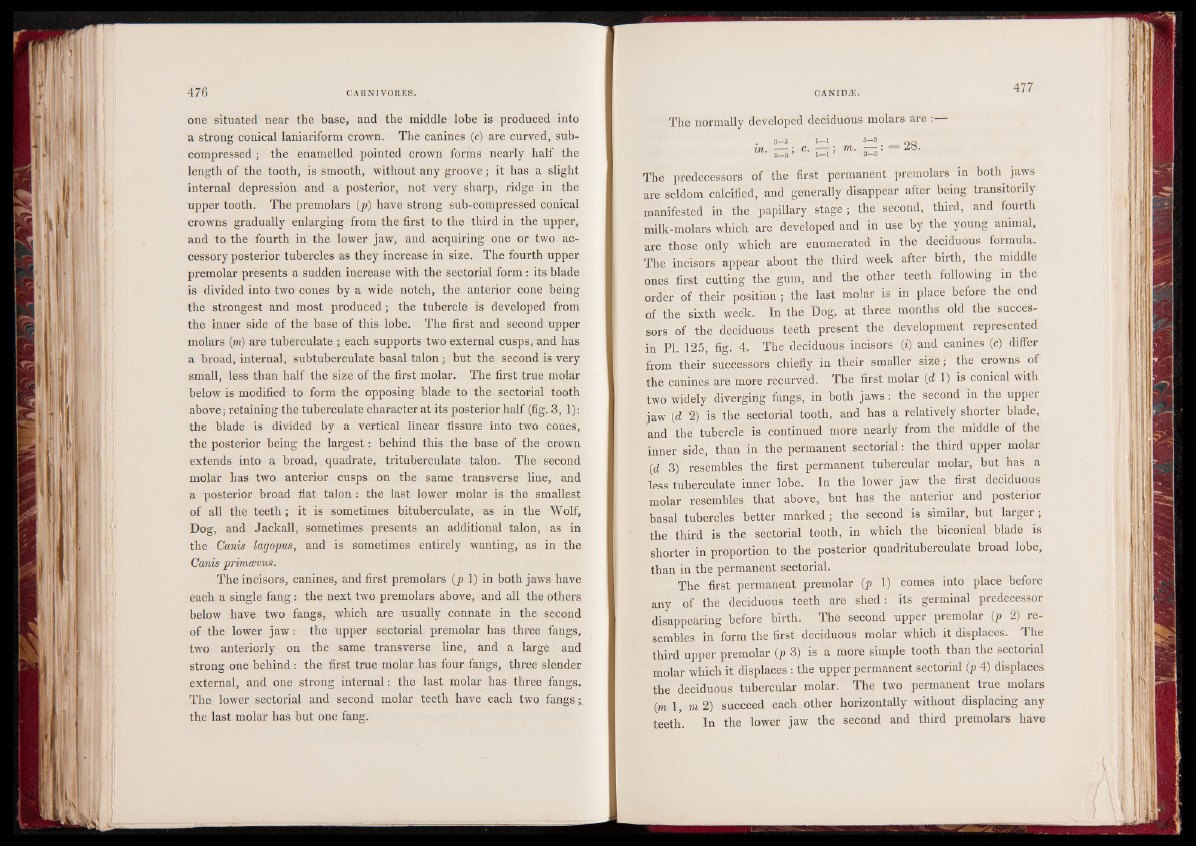
one situated near the base, and the middle lobe is produced into
a strong conical laniariform crown. The canines (c) are curved, subcompressed
; the enamelled pointed crown forms nearly half the
length of the tooth, is smooth, without any groove; it has a slight
internal depression and a posterior, not very sharp, ridge in the
upper tooth. The premolars (p) have strong sub-compressed conical
crowns gradually enlarging from the first to the third in the upper,
and to the fourth in the lower jaw, and acquiring one or two accessory
posterior tubercles as they increase in size. The fourth upper
premolar presents a sudden increase with the sectorial form : its blade
is divided into two cones by a wide notch, the anterior cone being
the strongest and most produced; the tubercle is developed from
the inner side of the base of this lobe. The first and second upper
molars (m) are tuberculate ; each supports two external cusps, and has
a broad, internal, subtuberculate basal talon ; but the second is very
small, less than half the size of the first molar. The first true molar
below is modified to form the opposing blade to the sectorial tooth
above; retaining the tuberculate character at its posterior half (fig. 3, 1):
the blade is divided by a vertical linear fissure into two cones,
the posterior being the largest: behind this the base of the crown
extends into a broad,, quadrate, trituberculate talon. The second
molar has two anterior cusps on the same transverse line, and
a posterior broad flat talon : the last lower molar is the smallest
of all the teeth; it is sometimes bituberculate, as in the Wolf,
Dog, and Jackall, sometimes presents an additional talon, as in
the Canis lagopus, and is sometimes entirely wanting, as in the
Cards primcevus.
The incisors, canines, and first premolars (p 1) in both jaws have
each a single fang : the next two premolars above, and all the others,
below have two fangs, which are usually connate in the second
of the lower jaw : the upper sectorial premolar has three fangs,
two anteriorly on the same transverse line, and a large and
strong one behind > the first true molar has four fangs, three slender
external, and one strong internal: the last molar has three fangs.
The lower sectorial and second molar teeth have each two fangs;,
the last molar has but one fang.
The normally developed deciduous molars are :
m• . 3—-3 ; c. H— ; m™ . —8-r3 : = ^o8a. 3—3 1—1 3 -3
The predecessors of the first permanent premolars in both jaws
are seldom calcified, and generally disappear after being transitorily
manifested in the papillary stage ; the second, third, and fourth
milk-molars which are developed and in use by the young animal,
are those only which are enumerated in the deciduous formula.
The incisors appear about the third week after birth, the middle
ones first cutting the gum, and the other teeth following in the
order of their position ; the last molar is in place before the end
of the sixth week. In the Dog, at three months old the successors
of the deciduous teeth present the development represented
in PL 125, fig. 4. The deciduous incisors (i) and canines (c) differ
from their successors chiefly in their smaller size; the crowns of
the canines are more recurved. The first molar (d 1) is conical with
two widely diverging fangs, in both jaws: the second in the upper
jaw (d 2) is the sectorial tooth, and has a relatively shorter blade,
and the tubercle is continued more nearly from the middle of the
inner side, than in the permanent sectorial: the third upper molar
(d 3) resembles the first permanent tubercular molar, but has a
less tuberculate inner lobe. In the lower jaw the first deciduous
molar resembles that above, but has the anterior and posterior
basal tubercles better marked ; the second is similar, but larger ;
the third is the sectorial tooth, in which the biconical blade is
shorter in proportion to the posterior quadrituberculate broad lobe,
than in the permanent sectorial.
The first permanent premolar (p 1) comes into place before
any of the deciduous teeth are shed: its germinal predecessor
disappearing before birth. The second upper premolar (p 2) resembles
in form the first deciduous molar which it displaces. The
third upper premolar {p 3) is a more simple tooth than the sectorial
molar which it displaces : the upper permanent sectorial (p 4) displaces
the deciduous tubercular molar. The two permanent true molars
(m l, m 2) succeed each other horizontally without displacing any
teeth. In the lower jaw the second and third premolars have